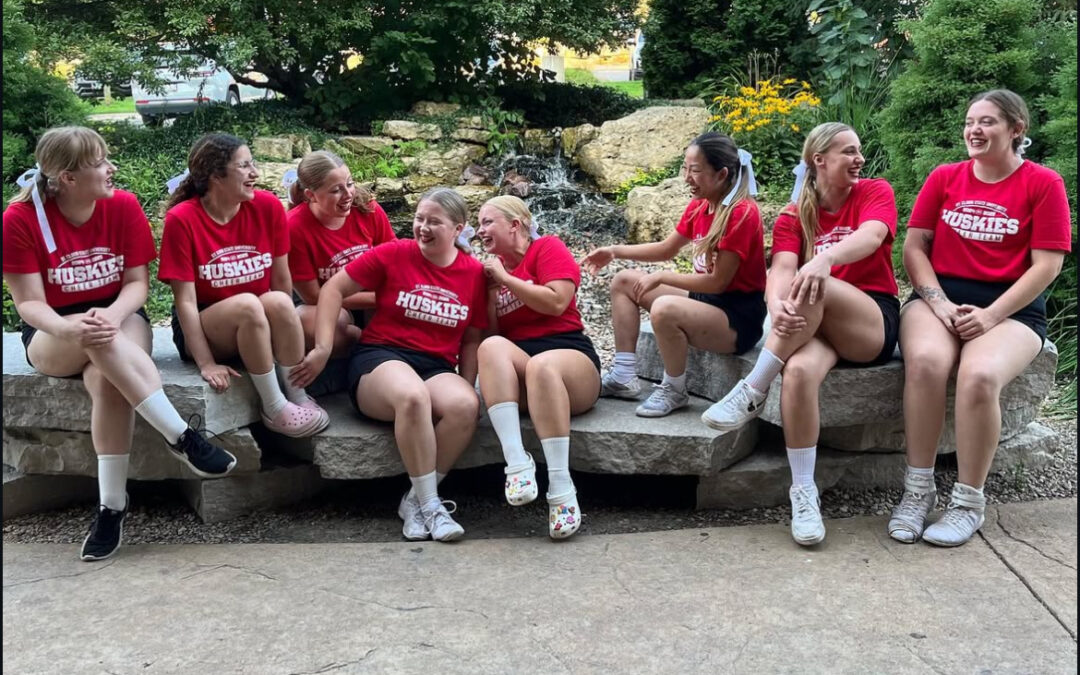Article by Olivia Simonson. Photo by Allie Patnode.
The athletics department at St. Cloud State has many nationally renowned sports teams. From achievements in wrestling to hockey, they have earned this honor. But a couple of teams on campus don’t always receive that same recognition. One team on campus doesn’t have competitions or their own games week after week – instead, they’re on the sidelines, cheering on other athletes, while they prepare for one major weekend every year.
That weekend is the annual Universal Cheerleading Association (UCA) nationals in Orlando. Leading up to this experience, the team goes through rigorous practice to prepare them for their 2 minutes on the mat.
“We usually go from the very beginning of spring semester and stay at Florida throughout the weekend,” says three-year member Allie Patnode. “In terms of prepping for nationals, we usually have around 3 practices a week and perform a couple of exhibitions at high school competitions to prepare. Leading up to nationals, our practices become a bit more intensive. Over winter break, we usually have what we call two-a-day practices, where we practice twice in one day with a break in between both practices. Finally, right before we leave for nationals, we perform for our families who come to watch all the hard work we’ve put into our season.”
Some make the mistake of confusing cheerleading with dance. For a novice viewer, the two appear almost identical, with similar costumes, movements, and music. But, for those who follow the sport and those who participate, the two are as different as night and day.
“I would say the main thing that differentiates cheer from dance is stunting. We heavily focus on the stunts we’re performing, whether that’s a sequence or a single stunt,” said Patnode, “Both involve rhythm, coordination, and performance, but cheer also incorporates tumbling, jumps, and vocal chants or cheers to engage the crowd. Dance, on the other hand, tends to emphasize choreography, technique, and fluid movement. Both are athletic and artistic, but the skill sets and goals differ.”
Stunting is when a cheerleader is lifted into the air by one or more teammates. The cheerleader in the air – known as the flyer – hits a variety of poses and may be tossed up for their teammates to catch.
“Stunting requires strength, precision, and teamwork, and it’s a core component of our routines,” said Patnode.
In recent years, there’s been an increased interest in cheerleading. Netflix released the documentary “Cheer” in 2020, showing those unfamiliar with cheerleading just how much effort goes into 2 minutes on the floor. Even with an uptick in fans, this sport is still often overshadowed, leaving athletes wishing that people understood that cheerleading is more than just a hobby.
“Competitive cheer requires athleticism, teamwork, and mental toughness. We train just like any other sport, pushing our bodies with stunts, tumbling, and conditioning,” said Patnode. “And for sideline cheer, we’re there to support and energize not just the team, but the entire crowd, no matter the weather or score. It takes passion, strength, and commitment.”
The team is already looking forward to next season, with team tryouts taking place on April 26 from 12 to 2. For new athletes, this can be an overwhelming experience, but the team isn’t looking for the perfect cheerleader – they’re looking for people who have passion.
“We’re excited to welcome athletes who are dedicated and willing to learn and grow,” said Patnode. “Before tryouts, we host a material day to teach the cheer and dance you’ll perform. If you can’t make it, everything is also posted on our tryout page on the Band app. We also use that day to practice stunting with others before tryouts. Tryouts are usually split into sections: one for cheer and dance, and one to show your stunting skills. We’re not looking for perfection—just effort, progress, and a positive attitude.”
Patnode will graduate in the Fall of 2025, and to her, cheering for St. Cloud State has been bigger than the competition and the sidelines. For her, it has become more than that.
“Being on the cheer team has truly been the best time of my life,” said Patnode. “Nothing compares to the love and dedication I see in my teammates, coaches, and myself when I am with this team. Every teammate plays such a vital role on our team, and it’s made me realize how important it is to appreciate people for who they are and what they contribute. It’s more than just stunts and sidelines—it’s about trust and showing up for each other. Our coach pushes us to be our best, not just as athletes, but as individuals. Being part of this team has taught me resilience, leadership, and how to stay positive even when things get tough. I just know that being part of cheer is something I’ll carry with me for the rest of my life.”






Recent Comments